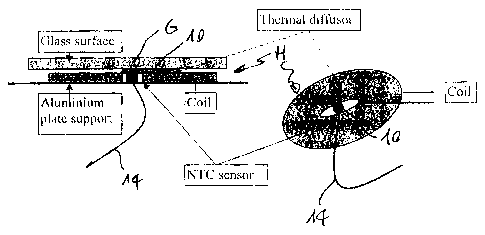Some of the information on this Web page has been provided by external sources. The Government of Canada is not responsible for the accuracy, reliability or currency of the information supplied by external sources. Users wishing to rely upon this information should consult directly with the source of the information. Content provided by external sources is not subject to official languages, privacy and accessibility requirements.
Any discrepancies in the text and image of the Claims and Abstract are due to differing posting times. Text of the Claims and Abstract are posted:
| (12) Patent: | (11) CA 2681846 |
|---|---|
| (54) English Title: | METHOD FOR DETECTING THE PRESENCE OF A COOKING VESSEL ON AN INDUCTION COOKING HOB AND HOB USING SUCH METHOD |
| (54) French Title: | METHODE DE DETECTION D'UN RECIPIENT DE CUISSON SUR UNE SURFACE DE CUISSON PAR INDUCTION, ET SURFACE DE CUISSON UTILISANT CETTE METHODE |
| Status: | Granted and Issued |
| (51) International Patent Classification (IPC): |
|
|---|---|
| (72) Inventors : |
|
| (73) Owners : |
|
| (71) Applicants : |
|
| (74) Agent: | SMART & BIGGAR LP |
| (74) Associate agent: | |
| (45) Issued: | 2018-03-20 |
| (22) Filed Date: | 2009-10-07 |
| (41) Open to Public Inspection: | 2010-04-21 |
| Examination requested: | 2014-10-01 |
| Availability of licence: | N/A |
| Dedicated to the Public: | N/A |
| (25) Language of filing: | English |
| Patent Cooperation Treaty (PCT): | No |
|---|
| (30) Application Priority Data: | ||||||
|---|---|---|---|---|---|---|
|
A method for detecting the presence of a cooking vessel on an induction heating element placed below a glass surface comprises detecting through a conductive electrode placed below the glass surface if a cooking utensil is placed on the induction heating element (H) by measuring capacitance, indicating to the user whether the cooking utensil is present on one or more induction heating elements, performing a second detection of the cooking utensil, after activation by the user, by feeding power to said induction heating element (H) and by assessing at least an electrical parameter of a power circuit thereof.
Une méthode de détection de la présence dun récipient de cuisson sur un élément de chauffage par induction placé sous une surface en verre comprend la détection à travers une électrode conductive placée sous la surface en verre si un ustensile de cuisson est placé sur lélément de chauffage par induction (H) en mesurant une capacitance, indiquant à lutilisateur si lustensile de cuisson est présent sur un ou plusieurs éléments de chauffage, effectuant une seconde détection de lustensile de cuisson, après une activation par lutilisateur, en alimentant de lénergie audit élément de chauffage par induction (H) et en évaluant au moins un paramètre électrique dun circuit dalimentation de celui-ci.
Note: Claims are shown in the official language in which they were submitted.
Note: Descriptions are shown in the official language in which they were submitted.

2024-08-01:As part of the Next Generation Patents (NGP) transition, the Canadian Patents Database (CPD) now contains a more detailed Event History, which replicates the Event Log of our new back-office solution.
Please note that "Inactive:" events refers to events no longer in use in our new back-office solution.
For a clearer understanding of the status of the application/patent presented on this page, the site Disclaimer , as well as the definitions for Patent , Event History , Maintenance Fee and Payment History should be consulted.
| Description | Date |
|---|---|
| Maintenance Fee Payment Determined Compliant | 2024-09-11 |
| Maintenance Request Received | 2024-09-11 |
| Common Representative Appointed | 2019-10-30 |
| Common Representative Appointed | 2019-10-30 |
| Grant by Issuance | 2018-03-20 |
| Inactive: Cover page published | 2018-03-19 |
| Pre-grant | 2018-02-06 |
| Inactive: Final fee received | 2018-02-06 |
| Change of Address or Method of Correspondence Request Received | 2018-01-12 |
| Letter Sent | 2017-08-07 |
| Notice of Allowance is Issued | 2017-08-07 |
| Notice of Allowance is Issued | 2017-08-07 |
| Inactive: Approved for allowance (AFA) | 2017-07-28 |
| Inactive: QS passed | 2017-07-28 |
| Amendment Received - Voluntary Amendment | 2017-04-07 |
| Inactive: S.30(2) Rules - Examiner requisition | 2016-11-02 |
| Inactive: Report - No QC | 2016-10-31 |
| Amendment Received - Voluntary Amendment | 2016-06-29 |
| Inactive: S.30(2) Rules - Examiner requisition | 2016-01-04 |
| Inactive: Report - No QC | 2015-11-26 |
| Letter Sent | 2014-10-24 |
| Request for Examination Received | 2014-10-01 |
| Request for Examination Requirements Determined Compliant | 2014-10-01 |
| All Requirements for Examination Determined Compliant | 2014-10-01 |
| Application Published (Open to Public Inspection) | 2010-04-21 |
| Inactive: Cover page published | 2010-04-20 |
| Inactive: IPC assigned | 2010-03-24 |
| Inactive: First IPC assigned | 2010-03-24 |
| Inactive: IPC assigned | 2010-03-23 |
| Inactive: IPC assigned | 2010-03-22 |
| Inactive: Declaration of entitlement - Formalities | 2009-12-09 |
| Reinstatement Requirements Deemed Compliant for All Abandonment Reasons | 2009-11-17 |
| Application Received - Regular National | 2009-11-09 |
| Inactive: Filing certificate - No RFE (English) | 2009-11-09 |
| Filing Requirements Determined Compliant | 2009-11-09 |
There is no abandonment history.
The last payment was received on 2017-09-08
Note : If the full payment has not been received on or before the date indicated, a further fee may be required which may be one of the following
Please refer to the CIPO Patent Fees web page to see all current fee amounts.
Note: Records showing the ownership history in alphabetical order.
| Current Owners on Record |
|---|
| WHIRLPOOL CORPORATION |
| TEKA INDUSTRIAL S.A. |
| Past Owners on Record |
|---|
| DIEGO NEFTALI GUTIERREZ |
| ETTORE ARIONE |